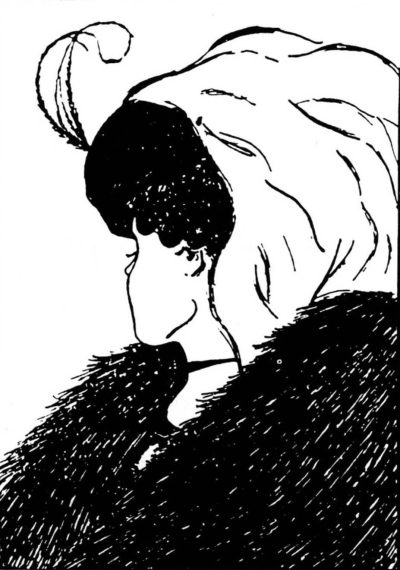This scenario should be familiar to the many of us. Let’s say you have just purchased a brand new iPhone. No sooner had you bought the phone, than you see brand new iPhones all over the place! Another classic example is that when women get pregnant; they suddenly start seeing pregnant women everywhere. After childbirth, they stop noticing pregnant women and start seeing babies everywhere. This is called selective perception.

Depending on their age, some people recognize a young lady, whilst others recognize an elderly woman. This picture succinctly captures the essence of selective perception. In other words, people tend to see the things that reinforce what they believe, or could relate to; the rest are usually disregarded.
Selective perception
In the book, What the Dog Saw: And Other Adventures, Malcom Gladwell describes seemingly usual incidents and how they are perceived by different people. If you’ve ever watched a TV crime drama, you’ve probably heard that eyewitness testimony is notoriously unreliable. A person commits a crime literally right in front of someone else. Yet, the eye-witness can’t identify key characteristics of the perpetrator. Worse, he / she gets the details wrong and implicates an innocent person.
Take two people who witness a single event and ask them about what happened. They will most likely share different versions of the same incident. However, through such an exercise, you’ll get a critical understanding of what selective perception is all about. From their accounts, you can gather extensive details about their values, ideas, attitudes, thoughts, roles and statuses they most care about.
Vantage Point
Vantage Point is a 2008 American political action thriller film directed by Pete Travis and written by Barry L. Levy. The story focuses on an assassination attempt on the President of the United States, as seen from the various vantage points of different characters. The film is often compared, unfavorably, to Akira Kurosawa‘s Rashomon, which also employed storytelling through multiple perspectives. Rashomon used the multiple perspectives to question the possibility of truth, in a process called the Rashomon effect. In contrast, Vantage Point recounts a series of events from different perspectives and viewpoints to reveal the truthful account of an incident.
Rashomon Effect
The Rashomon effect is a term related to the notorious unreliability of eyewitnesses. It describes a situation in which the individuals involved give contradictory interpretations or descriptions of the same event. The effect is named after Akira Kurosawa’s 1950 film Rashomon, in which a murder is described in four contradictory ways by four witnesses. The term addresses the motives, mechanism and occurrences of the reporting on the circumstance. The effect also addresses the contested interpretations of events and the existence of disagreements regarding the evidence of events. Furthermore, this effect also highlights material differences between subjectivity and objectivity in human perception, memory and reporting.
Trigger events
Events that we experience over the course of our lifetime trigger our perceptions. These actions, called trigger events, shape how we see or perceive any particular situation. We gradually revise and changed our perceptions each time we experience a new set of trigger events. Hence, selective perceptions are continually created and modified. This concept is particularly important in marketing. By concentrating on the set of trigger events, you can design successful marketing campaigns that resonate with your target target audience. In other words, trigger events help designing communication contexts that capture prospects’ attention and maximize the likelihood of a campaign’s success.
Selective Attention
The average person experiences over 1,500 ads or brand communications a day. Because a person cannot possibly attend to all of these stimuli, he / she will screen out much of the information flow. This process is called selective attention. Selective attention forces marketers to work harder to attract consumers’ attention. In other words, the challenge lies in identifying stimuli that people will respond to. In general, people are more likely to notice stimuli that:
- Relate to a current need
- They anticipate, or
- Whose deviations are larger compared to the normal size of the stimuli
The Invisible Gorilla
The Invisible Gorilla is a book published in 2010, co-authored by Christopher Chabris and Daniel Simons. This book is based on an earlier research by the authors. Their research findings reveal that people who are focused on one thing can easily overlook other obvious things. To demonstrate this effect they created a video where students pass a basketball among themselves. Then, the researchers asked the viewers to count the number of times the players in whites passed the ball to others. A majority of viewers were so focused on counting the number of passes that they failed to notice a person in a gorilla suit who appears in the center of the game. Psychologists consider this experiment:
one of the most famous psychological demos ever
Although people screen out much of the surrounding noise, unexpected stimuli, such as sudden offers in the mail, over the phone, or from a salesperson still influenced them. So, marketers attempt to promote their offers intrusively to bypass selective attention filters.
Selective Distortion
Even noticed stimuli do not always come across in the way the senders intended. Selective distortion is the tendency to interpret information in a way that will fit our preconceptions. Consumers will often distort information to be consistent with prior brand and product beliefs.
A stark demonstration of the power of consumer brand beliefs is the typical result of product sampling tests. In sampling taste tests, one group of consumers samples a product without knowing which brand it is, whereas another group of consumers samples the product knowing which brand it is. Invariably, differences arise in the opinions of the two groups despite the fact that the two groups are literally consuming exactly the same product.
Case of Coca-Cola
In the book, For God, country, and Coca-Cola, the author Mark Pendergrast describes the greatest challenge to Coca-Cola’s dominance in the 1970s when Pepsi came up with a simple, but incredibly effective advertising campaign. The Pepsi Challenge was a blind taste test. The testers presented the participants with two colas in unmarked plastic cups. They then asked the participants to taste the colas from both cups and choose the one they liked best. Subsequently, the tester lifted a small screen to reveal the brand the participants preferred.
This roughly nine second commercial triggered an epic battle between Coke and Pepsi for the hearts and minds and taste buds of cola drinkers. The ads incensed the marketing folks at Coca-Cola. They cried foul and considered the commercials misleading. In response, they introduced their own spots, featuring chimpanzees doing a blind taste test to mock Pepsi. However, they only managed to draw more attention to the Pepsi campaign.
The Pepsi Challenge
Pepsi had discovered a vulnerability in Coca-Cola’s otherwise ironclad image. They knew that if you presented the two drinks with their labels showing, most people would choose Coke because of the brand’s strong positive associations, but Pepsi also knew that their drink performed very well in blind taste tests, likely because it was sweeter. Pepsi was like David in the story of David and Goliath, and the blind taste test was a little rock that might just bring down the giant. By 1984, Pepsi had begun to outsell Coca-Cola in supermarkets.
In TV commercials that aired nationally for years, Pepsi showed the stunned reactions of loyal Coca-Cola drinkers who had chosen Pepsi over Coca-Cola in the test. One famous ad featured a grandmother. Her little granddaughter had persuaded her to take the Pepsi Challenge. The grandmother wasn’t sure why she was doing the test. She’d never had a Pepsi in her life, but she took a sip from Cup A and a sip from Cup B, and then it was revealed. The little girl shouted, “Grandma, you picked Pepsi!” And the grandmother said, “I can’t believe it. I’ve never had a Pepsi in my life, but it must be better.”
Why it worked?
When consumers report different opinions between branded and unbranded versions of identical products, it must be the case that the brand and product beliefs created by whatever means (e.g. past experience, marketing activity for the brand, etc) have somehow changed their product perception. Selective distortion can work to the advantage of marketers with strong brands when consumers distort neutral or ambiguous brand information to make it more positive. In other words, beer may seem to taste better, a car may seem to drive more smoothly, the wait in a bank line may seem shorter, and so on, depending on the particular brands involved.
How perception marketing works
Selective perception allows us to understand our customers’ internal mapping circuitry and how different audiences process and use information. The mapping results in a blueprint of internal mechanisms that is vital to customers’ purchase decision making. For marketers, selective perception marketing is about customizing messages to increase customers’ brand recall. By tapping into areas involved in purchase decision-making, they can positively influence the outcomes.
Today, marketing materials from several on- and off-line channels inundate customers. The divide between potential value and worthless buzz among those materials is nebulous. Hence, customers’ tendency is to shunt themselves from the marketing brouhaha. Instead, they seek other values in products or services that resonate with their own values . To achieve this feat, marketing messages must survive the ordeal of getting past consumers’ internal filter that automatically shuts out the advertising overload and outright rejects information not pertinent to their lives.
Case in point – Amazon
Most companies collect and analyze volumes of data about their customers and their shopping behavior. This is especially true of most online shops, such as Amazon, which sell a range of products. Users spend a considerable amount of time sifting through items. In this process, they provide Amazon with valuable feedback and behavioral information a.k.a Digital Exhaust. Such information and feedback are not normally available through brick & mortar businesses. When a user finally makes a purchase, the algorithms could trace the entire stream of actions that led to a sale. In this regard, event data, such as mouse clicks, product views, time spent, etc. are valuable.
Furthermore, by tracking a user’s past purchases, Amazon can fairly accurately predict and recommend items of interest to users. Thus, these items have a higher probability of a sale. Also, by collecting and processing similar purchases by other users, Amazon uses this information to refine the recommendation engine. As a result, the users find products of interest pretty quickly, which is tantamount to reducing the cost of information (in our case product) search.
Role of Big Data
Big Data plays a crucial role here. With a single user’s behavioral and shopping information, algorithms of the recommendation engine are only partly effective. The margin of error is pretty high. However, with Big Data, you can access:
- information about other users’ purchasing patterns
- a user’s past purchases
- behavioral information from browsing history / patterns on a website
- streaming data from a large population of several million users
- etc.
When you use such a large amount of data to train sophisticated machine learning algorithms, the quality of recommendation significantly improves. Subsequently, the recommendation engine adapts itself with new data to further reduce the margin of error and increase accuracy.
In short, recommendation engines simulate the internal mental circuitry to compute strategies to arouse the desired perception. Marketers can further influence purchase decisions through educated presentation approaches by leveraging the concept of choice architecture.
Amazon recommends only products of interest when a user logs in. This has a side effect of a cleaner and seeker web design that resonates well with the users. By selectively offering a limited set of products, Amazon de-clutters the website and leads shoppers only to those items of substantial perceived value & interest.
Thus, it is easy to infer the potential benefits of employing Big Data to support traditional marketing. Big Data and powerful algorithms help reduce the cost of information search. Furthermore, data can help position products & services of perceived value at strategic hot spots on websites.
To close on a quote from Peter Drucker:
the aim of marketing is to know and understand the customer so well the product or service fits him and sells itself.
Big Data proffers the means to achieving this end.




